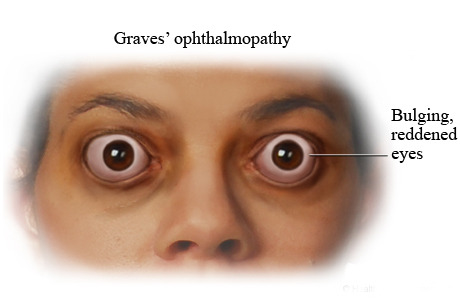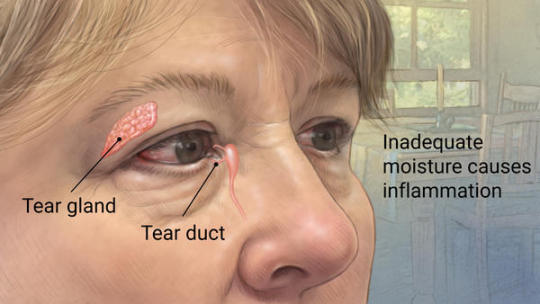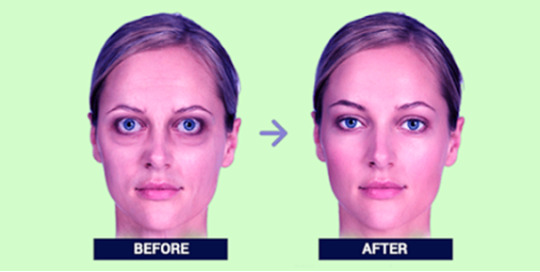Text
Dry Eye Disease
Signs and symptoms, which usually affect both eyes, may include:
A stinging, burning or scratchy sensation in your eyes
Stringy mucus in or around your eyes
Sensitivity to light
Eye redness
A sensation of having something in your eyes
Difficulty wearing contact lenses
Difficulty with nighttime driving
Watery eyes, which is the body's response to the irritation of dry eyes
Blurred vision or eye fatigue.
Dry eyes syndrome are caused by a lack of adequate tears. Your tears are a complex mixture of water, fatty oils and mucus. This mixture helps make the surface of your eyes smooth and clear, and it helps protect your eyes from infection.For some people, the cause of dry eyes is decreased tear production. For others it's increased tear evaporation and an imbalance in the makeup of your tears
0 notes
Text
Thyroid Eye Disease (TED or Graves Eye Disease)
Graves' eye disease, also known as thyroid eye disease, is an autoimmune condition in which immune cells attack the thyroid gland which responds by secreting an excess amount of thyroid hormone. As a result, the thyroid gland enlarges and excess hormones increase metabolism. The hypermetabolic state is characterized by fast pulse/heartbeat, palpitations, profuse sweating, high blood pressure, irritability, fatigue, weight loss, heat intolerance, and loss of hair and alterations in hair quality. When the immune system attacks the tissues around the eyes, it causes the eye muscles or fat to expand.
The eyes are particularly vulnerable to Graves' eye disease, because the autoimmune attack often targets the eye muscles and connective tissue within the eye socket. This likely occurs because these tissues contain proteins that appear similar to the immune system as those of the thyroid gland. Ocular symptoms can range from mild to severe; but only 10-20% of patients have sight threatening disease. Another tissue that can also be involved in the immune attack of Graves' eye disease is the skin of the shins.
0 notes
Text
Eyes, Bulging
Bulging or protruding of one or both eyes is called proptosis or exophthalmos. Exophthalmos is usually used when describing bulging eyes caused by Graves disease, a disorder causing overactivity of the thyroid gland (hyperthyroidism). Bulging eyes are not the same as prominent eyes. Some disorders that may change the appearance of the face and eyes but that do not cause true eye bulging include Cushing disease and severe obesity.
Bulging sometimes causes other symptoms. The eyes may be dry and irritated (which causes watering) because the bulging may prevent the eyelids from closing properly. Also, people may blink less often or may appear to stare. Depending on the cause of bulging, people may have other symptoms such as double vision or difficulty focusing on objects. If bulging is prolonged, the optic nerve is stretched, which may impair vision. Vision may also be impaired if the disorder causing bulging also presses on the optic nerve.
Causes
The most common cause in adults is Graves disease, which causes swelling of tissue behind and around the eye, pushing the eyeball forward. In children, the most common cause is infection.
Other causes are uncommon. They include tumors, bleeding, infections (in adults), and, rarely, inflammation of structures within the orbit without infection (called orbital pseudotumor). Glaucoma that is present from birth (primary infantile glaucoma) can cause the eyes to enlarge, which may seem to look similar to eyes that are pushed forward.
0 notes
Photo

The thyroid gland is located at the bottom-most part of the neck and is a very important part because of its metabolism regulation. This gland is responsible for the production of two important hormones and a lot of people suffer from either hyperthyroidism or hypothyroidism.
0 notes
Text
Treating dry eye syndrome
Treatment for dry eye syndrome helps to control the symptoms, but there's no cure. Some people may have recurring episodes for the rest of their lives.
The exact treatment for dry eye syndrome depends on whether symptoms are caused by:
decreased production of tears
tears that evaporate too quickly
an underlying condition
The first thing to consider is whether there are any obvious factors, such as a medication, causing the symptoms.

If your dry eye syndrome is caused by an underlying condition, your GP can prescribe treatment or refer you to an appropriate specialist.
You may also be able to help prevent dry eye syndrome or ease your symptoms by adjusting your environment, keeping your eyes clean, and improving your diet.
0 notes
Text
Tumours of the uveal tract
Melanoma
Uveal melanomas have an incidence of 6 per million per year. Most are choroidal, with the remainder arising from the iris and ciliary body. The melanoma arises in the pigmented uveal tract (the middle layer of the eye, between the sclera and the retina).
Choroidal melanoma
This is the most comon site - it is the most common primary intraocular malignant tumour. See separate Choroidal Melanoma article.
Iris melano
5% of uveal melanomas. Iris melanoma is the least common site of primary uveal melanoma but it has the best prognosis. It is three times more common in blue/grey irides and rare in people of Afro-Caribbean ethnicity. Predisposing conditions include dysplastic cutaneous naevi, familial melanoma and neurofibromatosis. The increased iris pigmentation associated with latanoprostdoes not appear to be a risk facto
0 notes
Photo

The thyroid gland is located at the bottom-most part of the neck and is a very important part because of its metabolism regulation. This gland is responsible for the production of two important hormones and a lot of people suffer from either hyperthyroidism or hypothyroidism
0 notes
Text
Bulging Eyes Symptoms & Treatment
Proptosis, or exophthalmos, is the bulging out of one eye (unilateral) or both eyes (bilateral). Cases of proptosis develop for reasons ranging from variations in our anatomy to the development of another condition such as hyperthyroidism, of which bulging eyes are a symptom.
If a person suddenly develops exophthalmos, especially in both eyes, it is considered a very serious problem. Sudden onsets of proptosis should always be evaluated by an eye doctor immediately.In mild cases of proptosis, a doctor can take measurements with a special ruler known as an exophthalmometer.

If measurements are within a certain range, more testing is unnecessary. If measurements are out of the normal range, however, other tests will be conducted, possibly including an MRI, blood work, ultrasound, or even a biopsy.Proptosis can become a very serious situation for some people. The bulging orbit may increase the intraocular pressure behind and inside the eye. As the intraocular pressure increases, so do risks for other eye diseases such as glaucoma.Other Terms for Bulging Eyes There are many different names experts use when referring to bulging eyes, such as:ProptosisProtruding EyesExophthalmosBulging Eyes
0 notes
Link
Saraswathi Eye Hospital Madurai specialized in treatment for myopia and we offer affordable cost for high myopia correction and thyroid related eye problems
0 notes
Text
Thyroid Eye Disease
In thyroid eye disease the muscles and fatty tissues within the eye socket (orbit) become inflamed and swollen, pushing the eyeball forward and affecting the movements of the eye. In severe cases vision may be affected. It is usually (but not always) associated with an overactive thyroid gland (hyperthyroidism) - and most often with one particular cause of an overactive thyroid gland, Graves' disease.
There is limited space inside the orbit so, as the tissues swell, the eyeball is pushed forward. Usually this is mild, but in severe cases the eye is pushed far enough forward that the eyelids don't close as effectively. This leaves the clear window in the front part of the eye (the cornea) dry and unprotected. The eyeball also cannot move so easily as the muscles that control it work less well. When the disease is very severe, the nerve connecting the eyeball to the brain can be compressed and damaged.
In thyroid eye disease there is an 'active phase' - a period of inflammation and swelling - followed by a healing response.
Thyroid eye disease is sometimes called other names such as thyroid ophthalmopathy, dysthyroid eye disease, Graves' ophthalmopathy or ophthalmic Graves' disease. However, a significant minority of cases are not associated with Graves' disease.
0 notes
Text
What Causes Myopia In Children?
Although the exact reason why some children become nearsighted and others do not is not fully understood, it appears heredity is a factor, but not the only one.
Are bookworms more likely to be nearsighted than other children? Some researchers and eye doctors think so, but the evidence is not clear-cut.
In other words, if both parents are nearsighted, there is a greater risk their children will be nearsighted, too. But you can't predict who will become nearsighted by simply looking at their family tree.
In my case, my parents and both my older brothers had perfect vision. I'm the only one in the family who is nearsighted. Go figure.
I loved to read when I was a kid (still do); my brothers, not so much. Some researchers think focusing fatigue from excessive reading or holding a book too close to your eyes for extended periods can increase the risk for myopia in children. But nobody knows for sure.
The cause (or causes) of low myopia and high myopia may remain a mystery, but researchers recently have discovered something about the progression of nearsightedness that is very interesting: conventional glasses and contact lenses that have been prescribed for years to correct myopia may actually increase the risk of myopia worsening throughout childhood!
0 notes
Text
What are the treatment options for bulging eyes?
Eye bags or bulging eyes treatment can vary from non-surgical to plastic surgery for patients with thyroid disease, such as Graves. The first non-invasive option to consider is office filler injection in the lower eyelid area to help soften or camouflage the appearance of the bulge. Facial filler treatment (ex. Restylane) is a quick procedure performed in the office via local anesthesia. Results are immediate and last for several months or longer.

The second less invasive option is fat injection. Results may last longer with fat injection, but recovery with bruising and swelling takes longer.
A more permanent option, however, is plastic surgery where bone and/or fat around the eye is removed to allow the eye to settle back. This type of surgery may be performed by oculoplastic or facial plastic surgeons, or sometimes both surgeons at the same time as needed.
0 notes
Text
What is Proptosis?
This is a problem with the eyes also commonly known as exophthalmos. This is a condition where 1 or both of the eyes bulge out. There are some individuals who have eyes that seem to bulge naturally because of disparities in the human anatomy.

Other individuals can develop this problem. If an individual suddenly develops proptosis it is believe to be serious. Sudden proptosis onset needs to always be evaluated by an eye doctor.
0 notes
Text
Dry Eye Syndrome Treatments
Dry eye disorder is brought on by a perpetual absence of adequate oil and dampness on the surface of the eye. Outcomes of dry eyes run from unpretentious yet steady eye bothering to noteworthy aggravation and notwithstanding scarring of the front surface of the eye.
Notwithstanding being called dry eye syndrome, dry eye sickness, or just "dry eye," elective medicinal terms used to depict dry eyes include:
Keratitis sicca. By and large used to portray dryness and aggravation of the cornea.
Keratoconjunctivitis sicca. Used to depict dry eye that influences both the cornea and the conjunctiva.
Useless tear disorder. Used to underline that insufficient nature of tears can be similarly as imperative as deficient amount.
As appeared here, dry eyes can end up noticeably red and disturbed.
Dry eyes can end up plainly red and bothered, bringing on a sentiment scratchiness.
Predominance Of Dry Eye
Dry eyes are exceptionally normal, and dry eye disorder is a noteworthy explanation behind visits to the eye specialist. A current online survey uncovered that almost half (48 percent) of Americans age 18 and more seasoned frequently encounter dry eye manifestations.
Additionally, comes about because of a 2012 Gallup survey demonstrate that more than 26 million Americans experience the ill effects of dry eyes, and this number is relied upon to increment to more than 29 million inside 10 years.
Different sources assess that about five million Americans age 50 and more established have clinically huge dry eye disorder, and dry eyes influence almost twice the same number of ladies as men.
Dry Eye Symptoms
Indications of dry eyes and dry eye disorder include:
Consuming sensation
Bothersome eyes
Throbbing sensations
Overwhelming eyes
Exhausted eyes
Sore eyes
Dryness sensation
Red eyes
Photophobia (light affectability)
Obscured vision
Another regular side effect is something many refer to as a remote body sensation — the inclination that coarseness or some other question or material is "in" your eye.
Furthermore, as odd as it might sound, watery eyes likewise can be a side effect of dry eye disorder. This is on account of dryness on the eye's surface in some cases will over-fortify generation of the watery part of your tears as a defensive system. Be that as it may, this "reflex tearing" does not remain on the eye sufficiently long to amend the hidden dry eye condition.
0 notes
Text
Bulging Eyes
What Causes Bulging Eyes?
Bulging eyes have been linked to a number of diseases and conditions, including glaucoma, hyperthyroidism, leukemia, and more.
The most common cause of bulging eyes is Graves’ disease, or more specifically, Graves’ ophthalmopathy – an autoimmune condition where the thyroid gland mistakenly senses harmful cells and releases antibodies, which then fuse to eye muscles and cause inflammation.
Symptoms of Bulging Eyes
Bulging eyes are usually a symptom of another condition. Symptoms of Bulging eyes may include
Appearance of protruding eyes
Excessive dryness in eyes
Visible whiteness between the top of the iris and the eyelid
Eye pain
Eye redness
Treatment for Bulging Eyes
The underlying cause of bulging eyes will determine the overall course of treatment. However, in all cases, bulging eyes will be exposed to more air making it difficult to keep them lubricated. To combat excessive dryness, artificial tears and eye drops can be used for moisture and lubrication.
0 notes
Text
Causes of Dry Eye
There are various alternatives. Ask your eye specialist what to do. Medicines include:
Manufactured tear drops and balms. This is the most widely recognized treatment. Many sorts of drops are accessible over the counter. Nobody item works for everybody, so you may need to attempt a couple to make sense of the one truth is stranger than fiction for you. On the off chance that you have endless dry eye Syndrome, you have to utilize the drops notwithstanding when your eyes feel fine, or they won't remain sufficiently wet. In the event that your eyes dry out while you rest, you can utilize a thick item, similar to a treatment, around evening time. You may consider laying down with hermetically sealed goggles on. They'll make a smaller than expected "dampness chamber" for your eyes
0 notes
Text
Symptoms of Bulging Eyes
Around 30 percent of individuals with Graves' ailment give a few hints and manifestations of a condition known as Graves' ophthalmopathy. In Graves' Bulging Eyes, irritation and other insusceptible framework occasions influence muscles and different tissues around your eyes. The subsequent signs and side effects may include:
Swelling eyes (exophthalmos)
Lumpy sensation in the eyes
Weight or torment in the eyes
Puffy or withdrew eyelids
Blushed or excited eyes
Light affectability
Twofold vision
Vision misfortune
0 notes